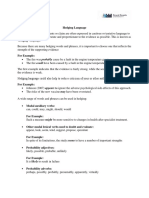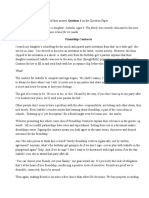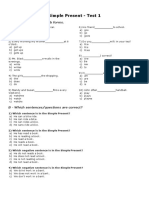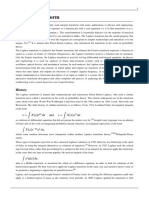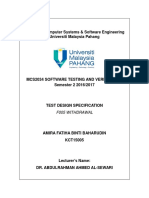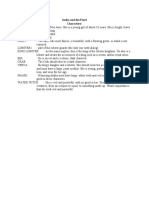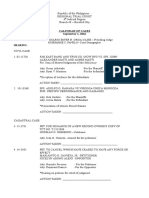100%(1)100% found this document useful (1 vote)
846 viewsDirected Writing Guide
Directed Writing Guide
Uploaded by
MasturaBtKamarudinThe document provides guidance on elements that are important for writing well, including vocabulary, language forms, idioms and proverbs, sentence structure, and paragraph structure. It emphasizes using vocabulary appropriately for the audience and purpose, and employing a variety of sentence structures, lengths, and styles. Formal language should be used for academic writing, while more informal expressions are suitable for other contexts. Idioms and proverbs can enhance writing if used sparingly and fit the purpose. Both simple and complex sentences should be included, and paragraphs should each center on a main topic and provide supporting details.
Copyright:
© All Rights Reserved
Available Formats
Download as DOCX, PDF, TXT or read online from Scribd
Directed Writing Guide
Directed Writing Guide
Uploaded by
MasturaBtKamarudin100%(1)100% found this document useful (1 vote)
846 views5 pagesThe document provides guidance on elements that are important for writing well, including vocabulary, language forms, idioms and proverbs, sentence structure, and paragraph structure. It emphasizes using vocabulary appropriately for the audience and purpose, and employing a variety of sentence structures, lengths, and styles. Formal language should be used for academic writing, while more informal expressions are suitable for other contexts. Idioms and proverbs can enhance writing if used sparingly and fit the purpose. Both simple and complex sentences should be included, and paragraphs should each center on a main topic and provide supporting details.
Original Description:
DIRECTED WRITING
Copyright
© © All Rights Reserved
Available Formats
DOCX, PDF, TXT or read online from Scribd
Share this document
Did you find this document useful?
Is this content inappropriate?
The document provides guidance on elements that are important for writing well, including vocabulary, language forms, idioms and proverbs, sentence structure, and paragraph structure. It emphasizes using vocabulary appropriately for the audience and purpose, and employing a variety of sentence structures, lengths, and styles. Formal language should be used for academic writing, while more informal expressions are suitable for other contexts. Idioms and proverbs can enhance writing if used sparingly and fit the purpose. Both simple and complex sentences should be included, and paragraphs should each center on a main topic and provide supporting details.
Copyright:
© All Rights Reserved
Available Formats
Download as DOCX, PDF, TXT or read online from Scribd
Download as docx, pdf, or txt
100%(1)100% found this document useful (1 vote)
846 views5 pagesDirected Writing Guide
Directed Writing Guide
Uploaded by
MasturaBtKamarudinThe document provides guidance on elements that are important for writing well, including vocabulary, language forms, idioms and proverbs, sentence structure, and paragraph structure. It emphasizes using vocabulary appropriately for the audience and purpose, and employing a variety of sentence structures, lengths, and styles. Formal language should be used for academic writing, while more informal expressions are suitable for other contexts. Idioms and proverbs can enhance writing if used sparingly and fit the purpose. Both simple and complex sentences should be included, and paragraphs should each center on a main topic and provide supporting details.
Copyright:
© All Rights Reserved
Available Formats
Download as DOCX, PDF, TXT or read online from Scribd
Download as docx, pdf, or txt
You are on page 1of 5
At a glance
Powered by AI
The key takeaways are the importance of vocabulary, language forms, punctuation, paragraphs, idioms, proverbs and sentences in writing an essay.
The main elements of an essay are vocabulary, language forms, punctuation, paragraphs, idioms, proverbs and sentences.
Each paragraph of an essay should contain a topic sentence and one or more supporting sentences. The topic sentence states the main idea and the supporting sentences elaborate on and provide evidence for the topic sentence.
Mastura Kamarudin (Elements in an essay) Page 1
Directed Writing Guide - Language
What do we mean by language?
What do you need to write well?
All these elements would be used to compose a text to achieve the purpose of the task.
1.VOCABULARY
Appropriateness
When we talk about vocabulary, we refer to the use of words or expressions which are
considered most suitable, acceptable or correct in certain circumstances.
For example, in the sentences below, although both words are correct, the second word
would be more appropriate:
If we are to get / achieve this status, it is important that Malaysians check the decline in
the standard of English.
Make the library a place to visit every time you find the chance / opportunity.
Newspapers contain many / a variety of articles on topics ranging from current affairs to
sports.
Do not join the ranks of the unemployed who have not got/secured jobs because they are
not proficient in English.
Let us also look at the use of formal and informal language.
When you apply the 5Ws, make a note of the sender and the receiver (the audience)
because this affects the tone and style of the language.
Do not think that if your audience is your peer/friend/relative, you can use conversational
language which contains a lot of informal expressions, slang or colloquialisms.
For example, the opening paragraph of a formal letter cannot include greetings such as
How are you? or Hi but these can be used in a letter to a relative/friend/sibling etc.
What is formal and informal language?
Formal a style of writing that is very correct and suitable for official or important
occasions. (Abbreviated as fml in the dictionary.)
Informal not formal, relaxed and friendly. (Abbreviated as infml in the dictionary.)
Colloquial used in normal conversation but not formal writing.
Slang very informal words and expressions that are common in spoken language but not
thought suitable in formal situations. (Abbreviated as sl in the dictionary.)
Therefore, depending on the circumstance of the task, you will have to decide which of
the two you want to use formal or informal.
Under no circumstances can we use slang or colloquial language because if the task is a
piece of writing, the English has to be standard English.
Read the following extract, taken from an article in a school magazine. Look up the
meanings of the expressions in italics. Which of these expressions do you think are
appropriate for an article in a school magazine?
One of the best ways to improve our English is by reading materials written in the English
Language. As students, we are surrounded by reading material in school. Make the library
a place to visit every time you find the opportunity. I am sure our parents and teachers
willfreak out when they find us here. In fact, we will look pretty cool to our friends! If
you do not find anything suitable in the library, you can always buy them. But that does
not mean you must have a splurge on books. There are many second-hand bookshops
where books are going for a song. However, we must not get this starry-eyed notion that
our English will improve overnight. You need practice to become proficient. Remember
that Rome was not built in a day! So start reading today if you do not want to be on the
blink.
2.LANGUAGE FORMS
Directed Writing is special. Unlike Continuous Writing, there is a purpose to the task. The
purpose of the task can be any one of the following, or a combination of the following:
to inform
to persuade
to instruct
Mastura Kamarudin (Elements in an essay) Page 2
to seek permission
to request
to make suggestions etc.
If you are asked to write an article entitles Suggestions on how to improve your English.
You must know that the main purpose of your writing is to persuade readers to adopt
suggestions on how to improve their English. To achieve this purpose, you have to use the
correct language form.
You cannot command or order your readers. That tone would be inappropriate.
Avoid using imperatives such as the following:
Join a club!
Read more books!
Listen to songs!
Practise in front of a mirror!
The task says give suggestions, so you may use polite forms of suggestions such as Why
dont you, or include modal auxiliaries to express ability and possibility like can,
might, or offer advice by using words like should, must, ought to.
3.IDIOMS AND PROVERBS
The use of idiomatic expressions and proverbs are encouraged but only if they blend
naturally into the writing and are relevant. They are used for effect and help to
demonstrate fluency at using expressions natural to native speakers of a language. Do not
try to squeeze all the idioms
you know into one answer. An example of a proverb in the article is: Remember
that Romewas not built in a day!
4.SENTENCE
Structure
There are three basic sentence patterns you can use.
They are simple, compound and complex.
The most basic type is the simple sentence.
If you combine two simple sentences, you get a compound sentence.
If you combine an independent clause with a dependent clause, you get a complex
sentence.
Example:
Simple: My friend invited me to a party. I do not want to go.
Compound : My friend invited me to a party, but I do not want to go.
Complex : Although my friend invited me to a party, I do not want to go.
Of course, you can use the same sentence pattern because you are more confident of a
particular structure. But varied structures make more interesting reading. It is also proof
that you are capable of constructing sentences with different structures.
Look at the sentences below.
Can you name the types of structures they are?
Newspapers contain a variety of articles ranging from current affairs to sports.
The English Language has become the language of the world and is the lingua franca most
widely used in science and mathematics, technology, business and the mass media.
Students who prefer humour can choose to read jokes and cartoons.
Length
Sentences can also come in different lengths.
Of course, a longer sentence suggests you have greater control over the language.
I should remind you that you are not wrong if you choose to write only short sentences.
However, it would help if you can vary the length of your sentences so that reading your
answer will not be monotonous.
Variety
You will notice that four of the six sentences below begin with the same structure.
(1) You are not alone.
(2) Always ask your teachers and friends for help.
Mastura Kamarudin (Elements in an essay) Page 3
(3) You may not understand every thing you read or know the pronunciation of every word
you
come across.
(4) I doubt any teacher or friend will refuse to help a student who wants to learn.
(5) You can make an appointment with your teacher so that they can plan their schedules
to
help you.
(6) You can also form a self-help group who can meet once a week to discuss problems.
Sometimes you want to do this for a purpose.
In this case, the writer has used it to achieve a direct relationship between herself /
himself and the reader. It sets a conversational tone and sounds less impersonal.
A repetition of such a pattern can also be for emphasis.
However, you can improve on the paragraph below by changing the structure, for
example,
Original: (5) You can make an appointment with your teachers so that they can plan their
schedules to help you.
Revised: Why dont you make an appointment with your teacher so that they can plan
their schedule to help you.
Original: (6) You can also form a self-help group who can meet once a week to discuss
problems.
Revised: Alternatively, you can form a self-help group who can meet once a week to
discuss problems.
Remember, style of writing varies depending on the task.
Although the guidelines given here may not be appropriate for all the writing tasks, the
rules of grammar apply across the board.
Essay Writing: Paragraph and sentence structure
Paragraphing
Paragraphing is another important feature of essay structure. Paragraphs are units of
thought which help to break a large body of text into smaller sections so that it is easier
to read and to understand. In a well-constructed essay each new point in the argument is
presented and developed in a new paragraph.
Each paragraph of an essay should contain:
a topic sentence, and
one or more supporting sentences
The topic sentence states the main idea of the paragraph. While it is often the opening
sentence, it can also occur in other positions within the paragraph, and may even be the
final sentence. The remaining sentences elaborate upon, and provide evidence for, the
idea expressed in the topic sentence. There are many ways in which they can do this.
Some possible techniques are: definition, classification, analysis, examples and statistics,
comparison and contrast, examination of cause and effect.
Example of paragraph structure
topic
sentence
Whether exercise can also prolong life, and offer protection against coronary
disease is less certain.
1st
supporting
sentence
A major study of the exercise habits of a group of American college graduates
(Paffenbarger et al., 1993) concluded that those who participated in sport
during the fifteen year time frame of the study had a lower risk of coronary
disease, including a 23-29% lower chance of dying from any disease, than those
who were non-participants.
Mastura Kamarudin (Elements in an essay) Page 4
2nd
supporting
sentence
Extreme caution is needed when interpreting such findings, however, since it is
not known if those in the non-participant group were free of disease at the
beginning of the study, or if those who participated in sport were
simultaneously following a cholesterol lowering diet.
3rd
supporting
sentence
The fact that the difference in survival rate between the two groups was only
nine months raises further questions about the significance of the findings.
Sentences
In academic writing you are expected to write grammatically complete sentences. This
means that each sentence in your essay should consist of a complete thought, and should
make sense by itself. Using this explanation as a guide you should now be able to see that
"Everyone enjoys a holiday." is a complete thought, and therefore a sentence, whereas
"enjoying a holiday" is not, because it is an incomplete statement which requires more
information before it can stand alone.
To be grammatically complete a sentence requires a verb and a subject. The subject tells
you who or what the sentence is about, while the verb tells you about the subject ie. what
it does, did, will do etc, or about its existence. E.g.
subject verb subject verb
Duty calls. The tree fell.
Subjects and verbs can be single words or groups of words, e.g.
subject group verb group
Extreme caution may be needed.
Sometimes, the verb may also have a complement (ie. a group of words which provide
more information about the verb). e.g.
Mastura Kamarudin (Elements in an essay) Page 5
Vocabulary
Language
Forms
Punctuation
Paragraphs
Idioms and
Proverbs
Sentences
You might also like
- PeterDocument11 pagesPeterapi-282453335100% (3)
- "I Am Only A Girl" by Severn SuzukiDocument3 pages"I Am Only A Girl" by Severn SuzukiGiovanni DivinagraciaNo ratings yet
- Formal and Informal Register ExerciseDocument1 pageFormal and Informal Register ExerciseSyrian EagleNo ratings yet
- 0510 Esl Past PaperDocument12 pages0510 Esl Past Paperkalash parekhNo ratings yet
- Linear ProgrammingDocument24 pagesLinear ProgrammingTareq IslamNo ratings yet
- Impacts of Family Law (Muslim Law)Document164 pagesImpacts of Family Law (Muslim Law)The CSS Point100% (1)
- Plants People and Environmental QualityDocument169 pagesPlants People and Environmental Qualityece nurNo ratings yet
- Writing A LeafletDocument1 pageWriting A Leafletvanda510% (1)
- How To Pass AQA Papers 1 & 2 PowerPointDocument11 pagesHow To Pass AQA Papers 1 & 2 PowerPointTonyNo ratings yet
- Summary Writing: For Advanced English MajorsDocument22 pagesSummary Writing: For Advanced English MajorsLiar LiarNo ratings yet
- Reading & Writing: Exercise 4 (Summary Writing) : Read The Question ProperlyDocument3 pagesReading & Writing: Exercise 4 (Summary Writing) : Read The Question ProperlySujata PawarNo ratings yet
- Linking Words Crosscultural Communication Multiculturalism Inter - 123837Document2 pagesLinking Words Crosscultural Communication Multiculturalism Inter - 123837Xuexin Peng100% (1)
- Directed Writing Sample Answer PPT 2019Document1 pageDirected Writing Sample Answer PPT 2019nanthiniNo ratings yet
- Teacher Notes: Simple, Compound and Complex Sentence Worksheet Pack Simple, Compound and Complex Flash Cards GameDocument31 pagesTeacher Notes: Simple, Compound and Complex Sentence Worksheet Pack Simple, Compound and Complex Flash Cards GameRenice McFarlaneNo ratings yet
- Notes For CambridgeDocument3 pagesNotes For Cambridgeapi-275598201No ratings yet
- Cambridge English First Fce From 2015 Writing Part 2Document8 pagesCambridge English First Fce From 2015 Writing Part 2thujonasNo ratings yet
- Unit 3 Summative.Document8 pagesUnit 3 Summative.Oluwatomiwa100% (1)
- IGCSE English Language B: Section A OverviewDocument2 pagesIGCSE English Language B: Section A OverviewMuhammad Naimur Rahman100% (1)
- Embeding Quotes Power PointDocument11 pagesEmbeding Quotes Power PointSumati SachdevNo ratings yet
- English Reading Comprehension Tests Grade VDocument16 pagesEnglish Reading Comprehension Tests Grade VFrancel Anne100% (1)
- The Junior King's School Canterbury: One Hour (2 X 30 Minutes)Document3 pagesThe Junior King's School Canterbury: One Hour (2 X 30 Minutes)Robert Neumark JonesNo ratings yet
- 2 Letter WritingDocument7 pages2 Letter WritingDarius DaeNo ratings yet
- Summary Writing HandoutDocument3 pagesSummary Writing HandoutSoumik agarwallaNo ratings yet
- Email Writing GuideDocument5 pagesEmail Writing GuidesaifiNo ratings yet
- Booklet IGCSE SgoDocument42 pagesBooklet IGCSE Sgokingsley100% (1)
- Ext IGCSE Cambridge LanguageDocument31 pagesExt IGCSE Cambridge LanguagelalaaNo ratings yet
- How To Write A Film ReviewDocument12 pagesHow To Write A Film ReviewSwett Lian Pan0% (1)
- Forms of WritingDocument26 pagesForms of WritingJo Patrick100% (1)
- Punctuatio: What Is Punctuation? Why Use Punctuation?Document5 pagesPunctuatio: What Is Punctuation? Why Use Punctuation?rAJBS;DFNo ratings yet
- Cambridge IGCSE 0500 Language Paper 2 Mock ExamDocument3 pagesCambridge IGCSE 0500 Language Paper 2 Mock ExamJason Liew100% (1)
- Formal Letter IGCSE EnglishDocument2 pagesFormal Letter IGCSE EnglishAbdullah KamranNo ratings yet
- IGCSE English 0500 Journal WritingDocument24 pagesIGCSE English 0500 Journal WritingRupanjana Das100% (1)
- Formal Letter Format IgcseDocument6 pagesFormal Letter Format Igcseafmrgjwjcowaov50% (2)
- Discursive EssayDocument1 pageDiscursive EssayRafael Alejandro LezcanoNo ratings yet
- Argument by Emotive LanguageDocument6 pagesArgument by Emotive LanguageRcl ClaireNo ratings yet
- (Assessment) Directed Writing (IGCSE - Paper 2, Part 1) - 1Document4 pages(Assessment) Directed Writing (IGCSE - Paper 2, Part 1) - 1ni moNo ratings yet
- Hedging LanguageDocument2 pagesHedging LanguageSafat Al Mamun RonoNo ratings yet
- FET T2 Week 2 Grade 11 English Home Language Reading and Viewing Summary WritingDocument6 pagesFET T2 Week 2 Grade 11 English Home Language Reading and Viewing Summary Writingjaymejacobs219014043No ratings yet
- 03 0500 12 QP 2024 2 1Document12 pages03 0500 12 QP 2024 2 1fortn4427100% (1)
- IGCSE Practice Directed Writing Level 10Document6 pagesIGCSE Practice Directed Writing Level 10Eugene JosephNo ratings yet
- Directed Writing - Speech ExerciseDocument2 pagesDirected Writing - Speech Exerciseaaleen100% (1)
- How To Approach An IGCSE Text Analysis StudentDocument4 pagesHow To Approach An IGCSE Text Analysis StudentEugene Joseph100% (1)
- Secondary 4 Express English 1184 Paper 1 & 2 (II) AKDocument8 pagesSecondary 4 Express English 1184 Paper 1 & 2 (II) AKMenon HariNo ratings yet
- O Level English (Notes)Document161 pagesO Level English (Notes)haniaamirr13No ratings yet
- Essay Terms PDFDocument2 pagesEssay Terms PDFRohitKumarNo ratings yet
- Exercise 5 - Writing An Informal Letter - Email (Ultimate Guide)Document17 pagesExercise 5 - Writing An Informal Letter - Email (Ultimate Guide)Ayesha ShahzadNo ratings yet
- B9 Eye Witness Report Writing 1mc2fuhDocument11 pagesB9 Eye Witness Report Writing 1mc2fuhAkumi EdwardNo ratings yet
- Transactional Writing Task ListDocument1 pageTransactional Writing Task Listapi-325988444No ratings yet
- Sentence Structure Notes PDFDocument4 pagesSentence Structure Notes PDFjean wongNo ratings yet
- Directed WritingDocument25 pagesDirected WritingJoanne SoneNo ratings yet
- Summary Writing What Is A Summary?Document6 pagesSummary Writing What Is A Summary?Mukul Kumar RanaNo ratings yet
- What Is Pathetic FallacyDocument3 pagesWhat Is Pathetic FallacyJo Patrick100% (1)
- English Grammar - EllipsisDocument2 pagesEnglish Grammar - EllipsisChiby MirikitufuNo ratings yet
- Exemplars Ias Unit 1 Context Identity Wen01Document47 pagesExemplars Ias Unit 1 Context Identity Wen01Yuvashankar TheivendranNo ratings yet
- Discursive EssayDocument1 pageDiscursive EssayJuan Jiménez Almaraz100% (3)
- Summary Writing ExerciseDocument1 pageSummary Writing ExerciseShelly Ramkalawan100% (2)
- Discursive Essay PowerpointDocument76 pagesDiscursive Essay PowerpointTinNo ratings yet
- Directed WritingDocument9 pagesDirected WritingJuwairiah SalimNo ratings yet
- Descriptive Essay: Presented By: Miss SarahDocument13 pagesDescriptive Essay: Presented By: Miss Sarahfarheen ayaz100% (1)
- English Grammar for Secondary SchoolsFrom EverandEnglish Grammar for Secondary SchoolsRating: 1 out of 5 stars1/5 (1)
- No Mistakes Grammar Bites, Volume XXVII, “Subject and Verb Agreement” and “Capitalization Rules”From EverandNo Mistakes Grammar Bites, Volume XXVII, “Subject and Verb Agreement” and “Capitalization Rules”No ratings yet
- Two Wolves Book Review PDFDocument1 pageTwo Wolves Book Review PDFOtto KnuepferNo ratings yet
- SImple Present Practice #1 PDFDocument3 pagesSImple Present Practice #1 PDFjose luis100% (1)
- Aacs1473 Introduction To Information Technology Assignment: Learning Outcome Being AssessedDocument4 pagesAacs1473 Introduction To Information Technology Assignment: Learning Outcome Being AssessedLEE JUN WEINo ratings yet
- ME401-1 2 2-LaplaceTransform PDFDocument18 pagesME401-1 2 2-LaplaceTransform PDFAlessioHrNo ratings yet
- Secrets BoxDocument7 pagesSecrets Boxdina EzzatNo ratings yet
- Test Design SpecificationDocument7 pagesTest Design SpecificationAmira Eira100% (1)
- Necklace AssignmentDocument3 pagesNecklace AssignmentRishi RameshNo ratings yet
- Reheating of The Universe As Holographic ThermalizationDocument5 pagesReheating of The Universe As Holographic ThermalizationR DaniNo ratings yet
- Initial Care of The Severely Injured PatientDocument8 pagesInitial Care of The Severely Injured Patientjunior guedesNo ratings yet
- Illiterate HeartDocument7 pagesIlliterate Heartriaw181201No ratings yet
- Comparing and Ordering FractionsDocument22 pagesComparing and Ordering FractionsAnonymous ch3bLFwOnNo ratings yet
- Essentials of Valid Will (Wasiyat) (Cont.)Document4 pagesEssentials of Valid Will (Wasiyat) (Cont.)kuku_29No ratings yet
- Judicial Misconduct Complaint Motion Under Rule 26Document11 pagesJudicial Misconduct Complaint Motion Under Rule 26EvangelionNo ratings yet
- Benifit MotiDocument4 pagesBenifit MotiFehmina syedNo ratings yet
- Leo Strauss - Plato & Aristophanes (1960)Document264 pagesLeo Strauss - Plato & Aristophanes (1960)Giordano BrunoNo ratings yet
- Orchestrating Time: Arrangements of The Brain Circadian ClockDocument7 pagesOrchestrating Time: Arrangements of The Brain Circadian ClockAhmad Haikal Ahmad MochtarNo ratings yet
- KMC - GEC Semester I (2023-24) - Final List : Botany: Protected Agriculture - Hydroponics and Organic CultivationDocument135 pagesKMC - GEC Semester I (2023-24) - Final List : Botany: Protected Agriculture - Hydroponics and Organic CultivationdhingrakajitNo ratings yet
- LSG Unit 1Document12 pagesLSG Unit 1smritig1199No ratings yet
- Chinese StatueDocument6 pagesChinese StatueUnc lutchedNo ratings yet
- Personal Vs Business BrandDocument2 pagesPersonal Vs Business BrandPatricia Wilson-SmithNo ratings yet
- Grade 7 CHEMISTRY HandoutsDocument3 pagesGrade 7 CHEMISTRY HandoutsCestlavi Santos100% (2)
- 5 6276139296218939455-1Document603 pages5 6276139296218939455-1Anbreen ShaikNo ratings yet
- Sasha and The Pearl Drama ScriptDocument9 pagesSasha and The Pearl Drama ScriptAndi DermawanNo ratings yet
- Calendar of CasesDocument6 pagesCalendar of CasesRtc Forty Eight BacolodNo ratings yet
- Cultural Behaviour in BusinessDocument4 pagesCultural Behaviour in BusinessThân Thu CảnhNo ratings yet
- Pathognomonic Signs of Communicable Diseases: JJ8009 Health & NutritionDocument2 pagesPathognomonic Signs of Communicable Diseases: JJ8009 Health & NutritionMauliza Resky NisaNo ratings yet
- The Journey in The Other World According To Ancient Egypt - I. .P. .H. . Guillermo Calvo Soriano, 33rdDocument70 pagesThe Journey in The Other World According To Ancient Egypt - I. .P. .H. . Guillermo Calvo Soriano, 33rdsupremo7No ratings yet




































